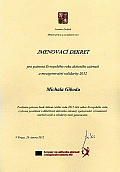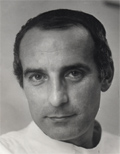RNDR. Michal GIBODA, CSc, Associated Professor, is both an internationally known human parasitologist and chair of Civic Group “Dialogue between Science and Art” . He has experiences from basic research, especially in tropical medical parasitology, and extensive field research in tropical countries like Cambodia, Laos, Yemen, Cuba, Puerto Rico. As an invited speaker he gave the lectures on scientific meetings in Canada, Brazil, Japan, Germany, Russia. Research focused on pharmacological modulation of granuloma formation around the eggs of Schistosoma mansoni parazite, was supported by a grant from the Tropical Diseases Research Program by WHO in Geneva. The Medical Research Council of Canada awarded him to study the immunomodulative capacity of antifibrotic treatment of S. mansoni infection at the Institute of Parasitology, McGill University in Montreal. During his six-years’ work for San Juan Bautista School of Medicine in Puerto Rico as a chair of the Department of Microbiology, his most important discovery was that transmission of the parasitic worm S. mansoni was interrupted on an island by displacement of its snail intermediate host Biomphalaria glabrata, by other snail Thiara granifera, introduced to the island from the Far East.
This was for the first time in history that “Mother Nature” solved the problem. In spite of the transmission interruption the people died from the persisting pathology due to granulomatous scars caused by immunopathological response to S. mansoni eggs in the liver. Based on the experiences of Dr. Giboda and others, a new subject “Post-transmission schistosomiasis” for clinical and basic science research was established. A special issue of Acta Tropica (Vol. 77, 2000) published the Proceeeings of a Meeting held in San Juan, Puerto Rico, and organized by M. Giboda, as fundamental data for further studies. Dr. Giboda work on malaria is well-known, specially on multiple drug resistance based on studies in Cambodia. Team work in Laos brought new insight on the problem of small flukes transmitted from fish to humans, on malaria and intestinal parasites.
Art was always a secret love of M. Giboda. Earlier interest in painting was replaced by writing, especially for the newspaper, TV script, and essays. His travel stories from exotic countries where he carried out his professional duties and other sites of his extensive travel are well-known. He is a member of the Syndicate of Journalists of the Czech Republic.
The complete curriculum vitae can be found here --> Curriculum ![]()
The complete curriculum vitae in czech language -->
Curriculum CZ ![]()
In the last period of his professional carrier he concentrated his energy on the activity which can be described as a Dialogue between Science and Art. The Civic Initiative Group was established in 2002 as an official ground for such activities. For the first time in the summer of 2002, the Civic Initiative Group organized a symposium about the integration of science and art accompanied by an art exhibition both with international participation. From the genetically engineered foods we eat the miracle cures through gene therapy, biotechnology may well be as significant in this century as mechanization was in the last century. In response to biotechnology becoming a greater part our daily lives, there is a growing movement in the art world to integrate science and art. To address this issue to Czech society, the workshop in the summer of 2003 is organized to implement the insight on new scientific discoveries not only as a source of new technologies, but as a great metaphoric adventure offering inspiration for contemporary art. This emerging topic is exciting for the Czech Republic.







